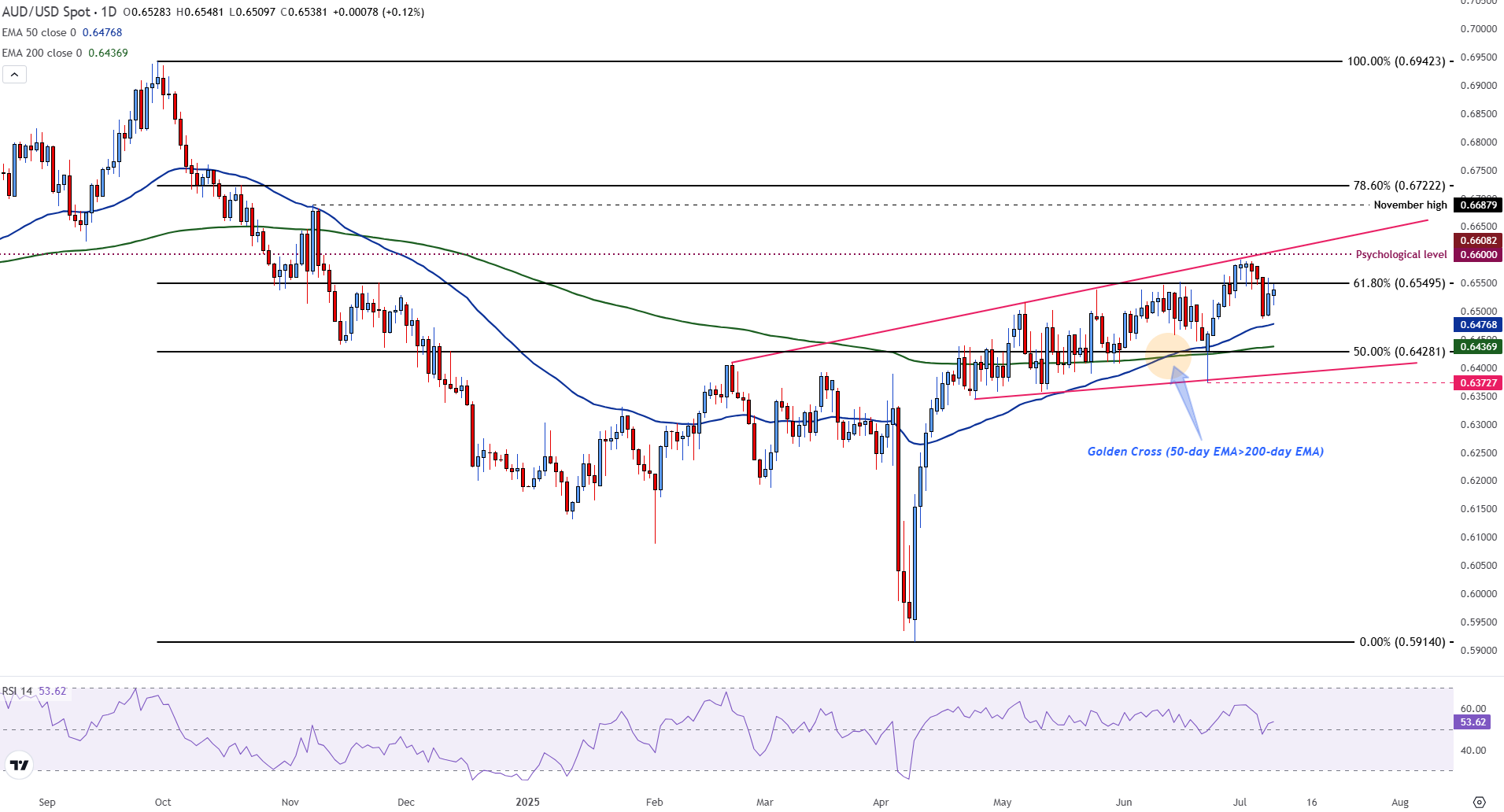Created
: 2025.07.10














![]() 2025.07.10 04:20
2025.07.10 04:20
The Australian Dollar (AUD) is trading in a well-defined range against its US Dollar (USD) counterpart on Wednesday, as markets digest the latest Fed Minutes and fresh tariff-related headlines.
Although tariffs are set to take effect in August, lingering trade uncertainty continues to weigh on the Greenback. The latest round of tariff letters was sent to countries including Libya, Iraq, and the Philippines on Wednesday.
At the time of writing, AUD/USD is trading around 0.6540, with resistance firming at 0.6550.
The Federal Open Market Committee (FOMC) Minutes from June revealed that most policymakers remain cautious about reducing interest rates prematurely. However, many also acknowledged the potential for tariffs to exacerbate inflationary pressure.
On Tuesday, President Trump called for the immediate resignation of Fed Chair Powell, urging his replacement with someone more inclined to cut rates. Speaking at the White House on Wednesday, Trump reiterated his position, stating the US should have "the lowest interest rates in the world."
Despite the political rhetoric, the CME FedWatch Tool continues to reflect expectations of a rate cut in September. With these projections largely priced in, the AUD/USD has shown little reaction to the Fed report.
AUD/USD is trading near 0.6540, with resistance firming at 0.6550, a level that aligns with the 61.8% Fibonacci retracement of the September-April decline.
Price action currently remains within a broadening, rising wedge formation. This is a pattern, characterized by a series of higher highs and higher lows, which widens toward the top.
The pair is currently consolidating just below the upper boundary of the wedge, with support layered near the 50-day Exponential Moving Average at 0.6476 and the 200-day EMA at 0.6437.
A recent Golden Cross, where the 50-day EMA moved above the 200-day EMA, supports a bullish medium-term outlook.
Meanwhile, the Relative Strength Index (RSI)near 54 indicates a slight bullish bias above the neutral zone at the 50 mark.
AUD/USD daily chart

A sustained breakout above 0.6550 would confirm bullish momentum and likely attract additional buying interest. In this case, the next upside target lies at the psychological 0.6600 level, followed by a potential advance toward the November high of 0.6688.
Conversely, a break below 0.6470 would signal weakening bullish pressure and suggest a potential downside reversal within the wedge structure. This would expose deeper support at 0.6428, near the 50% Fibonacci level, with further downside risk toward the 200-day EMA at 0.6437.
Monetary policy in the US is shaped by the Federal Reserve (Fed). The Fed has two mandates: to achieve price stability and foster full employment. Its primary tool to achieve these goals is by adjusting interest rates. When prices are rising too quickly and inflation is above the Fed's 2% target, it raises interest rates, increasing borrowing costs throughout the economy. This results in a stronger US Dollar (USD) as it makes the US a more attractive place for international investors to park their money. When inflation falls below 2% or the Unemployment Rate is too high, the Fed may lower interest rates to encourage borrowing, which weighs on the Greenback.
The Federal Reserve (Fed) holds eight policy meetings a year, where the Federal Open Market Committee (FOMC) assesses economic conditions and makes monetary policy decisions. The FOMC is attended by twelve Fed officials - the seven members of the Board of Governors, the president of the Federal Reserve Bank of New York, and four of the remaining eleven regional Reserve Bank presidents, who serve one-year terms on a rotating basis.
In extreme situations, the Federal Reserve may resort to a policy named Quantitative Easing (QE). QE is the process by which the Fed substantially increases the flow of credit in a stuck financial system. It is a non-standard policy measure used during crises or when inflation is extremely low. It was the Fed's weapon of choice during the Great Financial Crisis in 2008. It involves the Fed printing more Dollars and using them to buy high grade bonds from financial institutions. QE usually weakens the US Dollar.
Quantitative tightening (QT) is the reverse process of QE, whereby the Federal Reserve stops buying bonds from financial institutions and does not reinvest the principal from the bonds it holds maturing, to purchase new bonds. It is usually positive for the value of the US Dollar.
![]()
Created
: 2025.07.10
![]()
Last updated
: 2025.07.10

FXStreet is a forex information website, delivering market analysis and news articles 24/7.
It features a number of articles contributed by well-known analysts, in addition to the ones by its editorial team.
Founded in 2000 by Francesc Riverola, a Spanish economist, it has grown to become a world-renowned information website.
We hope you find this article useful. Any comments or suggestions will be greatly appreciated.
We are also looking for writers with extensive experience in forex and crypto to join us.
please contact us at [email protected].
Disclaimer:
All information and content provided on this website is provided for informational purposes only and is not intended to solicit any investment. Although all efforts are made in order to ensure that the information is correct, no guarantee is provided for the accuracy of any content on this website. Any decision made shall be the responsibility of the investor and Myforex does not take any responsibility whatsoever regarding the use of any information provided herein.
The content provided on this website belongs to Myforex and, where stated, the relevant licensors. All rights are reserved by Myforex and the relevant licensors, and no content of this website, whether in full or in part, shall be copied or displayed elsewhere without the explicit written permission of the relevant copyright holder. If you wish to use any part of the content provided on this website, please ensure that you contact Myforex.
Myforex uses cookies to improve the convenience and functionality of this website. This website may include cookies not only by us but also by third parties (advertisers, log analysts, etc.) for the purpose of tracking the activities of users. Cookie policy